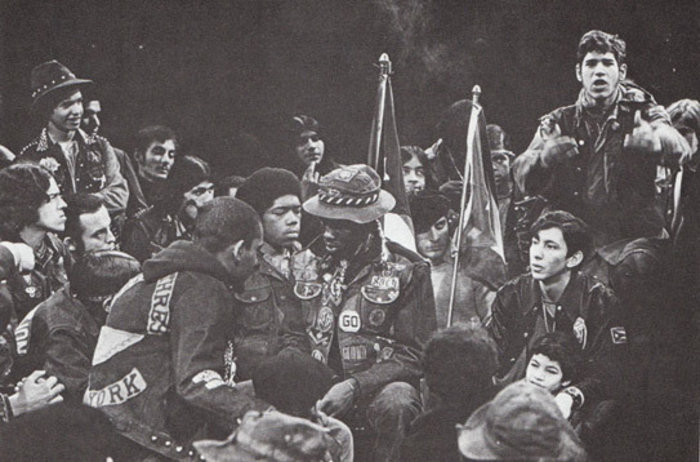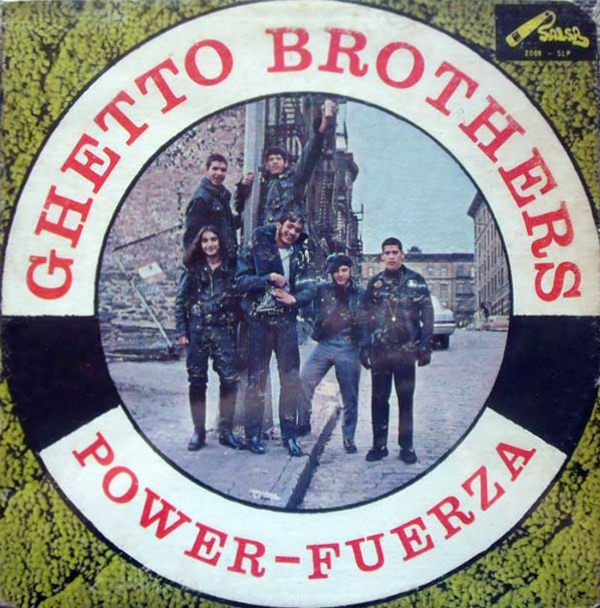
Real Gangsta Tunes
The recent release of the N.W.A. docudrama, Straight Outta Compton, has
many looking back, and wondering: where did a bunch of gang members get the
idea to make a record?
Never mind that the movie forgets to script the part where Dr. Dre (Andre Young,
a dedicated diver on his school's swim team) and DJ Yella (Antoine Carraby)
helped create the World Class Wreckin' Crew.
Also, the flick
doesn't showcase Ice Cube's 1986 rap skills, nor does it document his enrollment
at Phoenix Institute of Technology the following year for architectural drafting.
Truth is, that
these guys weren't really associated with gangs previous to the rise of N.W.A.
Before stardom, Easy E (Eric Wright) may have sold crack to get by, but even
that wouldn't get them close to being the first street toughs to lay it down
on wax. That honor is bestowed upon The Ghetto Brothers.

Starting as a local
street club around the late 60s in New York City's South Bronx, The Ghetto Brothers
later became involved in Puerto Rican nationalism, and had formed an association
with the Puerto Rican Socialist Party.
The gang first consisted of Ray de la Vega, Benjamin "Benjy" Melendez,
and Hui Cambrelen (who named the group). They had a rep for being trouble, but
also known for having a deeply philosophical side. The gang treated its women
members differently than most crews (calling them Ghetto Sisters), and even
became involved in charities.
By 1969, Benjamin began to notice the power he held, and took the position of
neighborhood spokesman. In December of 1971, after the death of one of the Ghetto
Brothers by a rival posse, he brokered a truce among the gangs of the Bronx
and Harlem at the Hoe Avenue peace meeting, which inspired the opening scenes
of the 1979 gang flick The Warriors.

However, he later
claimed his proudest moment would come up on the release a full LP, Power
- Fuerza, with his rock band, also called The Ghetto Brothers.

Getting into music
early on, Benjy (at only 11), formed The Junior Beatles, a cover band which
mixed Latin rhythms and rock. Luck shined down on him when he was offered the
opening slot for Tito Puente at the Embassy Club in 1964, so even with these
guys, music was in their veins before the gang life.
Still, when listening to the Ghetto Brothers' album, one doesn't get any hint
it's a bunch of thugs jamming, but is instead taken by the sense that someone
just really loved Santana enough to start a similarly sounding band.
The lyrics aren't
what you'd come to expect from gang members either, which includes three of
the eight tracks being love songs. To me, the most powerful song is the funk-dance
number "Ghetto Brothers Power", which isn't much more than a catchy
call-and-response number.
Produced by Bobby
Marin, the record was released on the Ghetto Bros own Salsa Records imprint,
and only sold locally. Though leaving the gang in 1976, Benjy was approached
to re-release Power - Fuerza on CD in 2008 by Brooklyn's Truth and Soul
Records.

Label co-owner,
Leon Michels, said that with eBay sales of original 12"es going into $1000
territory, and Benjy not even owning a copy himself, they just had to repress
it.
In the early 90s,
the Ghetto Brothers and the Savage Nomads joined together to form Los Solidos
("The Solid Ones"), currently one of the most powerful Puerto Rican
gangs in NY state. Other notable ex-members of GB are former-Hartford, CT mayor,
Eddie Perez, and New York Daily News columnist Robert Dominguez.
To get deeper into the story, check out the 2015 documentary, Rubble Kings.
A. Souto, 2015
BACK TO MUSICA OBSCURA ARTICLE LIST